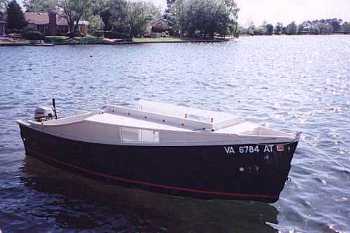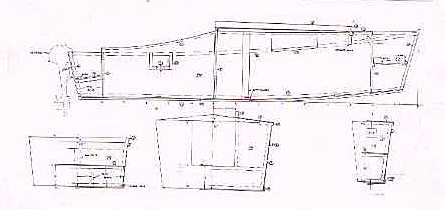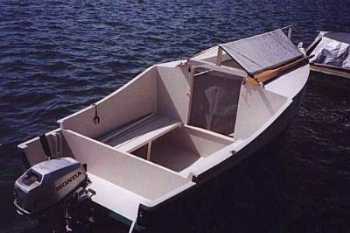Jim Michalak's Boat Designs
1024 Merrill St, Lebanon, IL 62254
A page of boat designs and essays.
(1 March 2019) We look a bit into hollow spars. The 15 March issue will look at the shape of underwater boards.
THE BOOK IS OUT!
BOATBUILDING FOR BEGINNERS (AND BEYOND)
is out now, written by me and edited by Garth Battista of Breakaway Books. You might find it at your bookstore. If not check it out at the.... ON LINE CATALOG OF MY PLANS......which can now be found at Duckworks Magazine. You order with a shopping cart set up and pay with credit cards or by Paypal. Then Duckworks sends me an email about the order and then I send the plans right from me to you.
REND LAKE 2019...
...will take place on June 7 and 8, always on the weekend before Father's Day weekend. I promised to remind all of us to try to get the good campsites on the North Sandusky loop. They are sites 24 through 30 and especially 26 through 29 if possible, this at the North Sandusky campground at Rend Lake. Let's give it a try. This is not really organized but if you nail one down, let me know. I will be trying too. UPDATE: AS OF DEC 6 WE HAVE ALREADY NAILED SITES 26 THROUGH 28. IF YOU DON'T GET A SITE NOW, DON'T FORGET THAT SEVERAL TENTS ARE ALLOWED AT EACH SITE AND YOU CAN DOUBLE OR TRIPLE UP ON A SITE. THERE WILL BE ROOM FOR ALL.
Hollow Spars
HOLLOW SPARS...
At first thought you might think that hollowing out spars is something you work hard at to save a lot of weight in the spars, and that could be true. But I've found that sometimes the hollow spar is the easy one to build and that you seldom save much weight. First a little theory:

The above figure shows the pattern of stresses in a beam that is under pure bending. Here the material is still in the "elastic" range, which is to say it it is not so highly loaded that it won't spring right back to its original shape once the load is removed. What is significant here is that compression and tension stresses develop that resist the bending and that the stresses are highest in the outer fibers of the beam. In the middle, at what is called the "neutral axis" there is no bending stress at all. You might think that the outer fibers are doing all the work, the inner fibers almost nothing. That would be just about correct in the conditon of pure bending but in real life the middle fibers do other important things. So you can't just remove the middle fibers totally but you can skinny them down in a beam meant to take mostly bending loads. The classic way to take advantage of the situation is with a I beam, where the outer fibers are thick and wide while the middle fibers are reduced to a thin web.
Similarly a tube has had its middle fibers removed. It does not have the bending strength of an I beam but has the advantage of being able to take bending loads in all directions because of its symmetry (unlike the I beam which is optimized for bending in just one plane) and is the optimum shape to handle torsion loads.

It's actually pretty easy to determine the effect of hollowing out a spar, which is to remove a lot of those middle fibers that don't do much, on strength and stiffness. The effects are pretty much related to the "moment of inertia" of the section which is fairly easy to calculate. Some of the sections you might use for a spar are shown above.
The reason the moment of inertia tells you so much is that in a beam under a bending load, the stress and deflection are both directly related to the moment of inertia. For example, all other things being equal, if you double the moment of inertia of a beam's cross section, both the stresses and the deflections will be cut in half.
So the next question becomes, "How does hollowing out a spar affect the moment of inertia of the spars cross section?
The answer is that you can figure the moment of inertia of the hollowed out cross section, provided the cross section is still symmetric, by subtracting the moment of inertia of the hollowed out area that you removed from the full unhollowed moment of inertia. Here are some examples:

Two things to point out here: First the moments are not reduced in proportion to the amount of material removed. You lose material a lot faster than you lose strength. For the 3" square the tube version reduces the section area by 25% but the reduction in the moment of inertia is but 6% Such a good deal!
Second, the square section is a lot stiffer and stronger than the round section with same width. The 3" square has 26% more area but its moment of inertia is 69% larger. Such a good deal! Some sail types like the lugsail or spritsail or even the sharpie sprit sail can use a square mast with little loss in sail efficiency. If your round mast flexes too much, convert to a square one! Can't do that with a gaff rig though because the gaff jaws insist on a round or octagonal mast.
By the way, another way to look at all of this is to see the effects of going to a smaller diameter mast. You quickly get yourself in trouble. The stiffness is proportional to the fourth power of the diameter or mast thickness. If you reduce the mast from 3" to 2", the mast stiffness is reduced by 80% !!
WEIGHT SAVINGS??...
Some types of masts are hard to make hollow, round masts in particular. Usually the mast is made in two halves and the center of each half hollowed out and then the two are glued back together. Some sections of the mast might not be hollowed out in order to have some beef there for fittings. So it's a bit of work. Indeed making a round mast is a bit of work even when solid.
Let's look at a typical mast to see how much weight is really saved. Let's use this one as an example. It is round and I've shown the diameter at distances along the mast along with the section area at those points.

The example shows the solid mast. The method of figuring the weight is to calculate the volume and then figure the weight from the density of wood which is typically about 30 pounds per cubic foot. The figure shows the volume calculated with a quick "curve of areas" where the area at each section is plotted along the length of the mast. The area under that "curve of areas" is the volume of the mast. Add them up and you get the volume of the total. In the example the mast would weigh about 22 pounds if solid.
You can use the same technique to figure the volume of about anything, including a hole. Here we'll use it to figure the volume of the hole in the center of the mast if it were hollow such that it had a 3/4" wall.

The proposed hollow amounts to about 4.4 pounds of wood. The hollow mast will weigh about 17.5 pounds instead of 22 pounds assuming it has no beefed up solid sections for fittings. Whether the work involved in hollowing out the mast is worth the trouble is something the individual must decide. But you can see that this mast has its weight reduced about 20%, its stiffness and strength reduced by about 6%.
BUT IT'S NOT ALWAYS EXTRA WORK...
I've built two hollow masts, one for my Birdwatcher and later another for my Jinni which had been coverted from a sharpie sprit to a balanced lug. I built hollow to allow an easier construction and not to save weight, although the hollow masts were lighter. Both used simple box construction from 3/4" boards like this:
The Birdwatcher mast was 5" across and the Jinni mast 2-1/2". The staves that formed the walls were scarfed to length first and then cut with a circular saw to the proper taper one at a time. Then the masts was assembled with glue and nails like simple boxes, 24' long in the case of the Birdwatcher and 14' long for the Jinni mast. By doing this I avoided having to saw and shape the taper of sticks that would be way to thick to cut with my saw, as it was I never cut any wood more than 3/4" thick.

Both masts worked quite well. The original Jinni mast was square in cross section even though it was a sharpie sprit sail. I doubt that the small square mast disrupted airflow as you might think. The Birdwatcher mast was supposed to be octagonal and hollow - a fairly involved building effort. You might think the 5" square mast that I built would really disrupt the airflow to the sail. To minimize the disruption I turned the mast 45 degrees to the axis of the boat like this:

I thought it worked out very well. The sail is laced to the mast and is somewhat free to align itself from side to side, unlike a sail that is trapped in a groove or track on the aft face of the mast. (Phil Bolger has written several times that a sail set on the mast with loose mast hoops as in the old gaff days has the best aerodynamics. More modern streamlined masts with sail track or grooves often are supposed to swivel on the deck at each point of sail to allow proper mast/sail alignment. You can see how complex the details can become.) One day I was out sailing in Birdwatcher and snapped a photo looking up the leading edge of the mast. The sail flowed right off the mast as in the above diagram. Alas, I can't find that photo. Here is one in which you can make out the "diamond" mast. (I think you can also see why I've stuck with the slot top cabins and offset masts that characterize the Birdwatcher layout):

So in this case I felt I had it all: light hollow mast, easy construction, and good aerodynamics. Still, I hardly ever draw hollow spars on plans because the drawings can get really complex and I don't want to deny anyone the challenge of brainstorming a new way to make a hollow mast. There seems to be no end to the ways of making one.
AF4Breve

AF4Breve, POWER CUDDY SKIFF, 15.5' X 5', 350 POUNDS EMPTY
Bruce Given of Virginia Beach, Virginia, did a perfect job on the AF4B prototype shown above. He said he didn't have the shop space to build the 18' AF4 and when I saw the photo of him working I believed him. So I scrunched the 18' AF4 down to 15.5'. I took 1' out of the cabin shortening it to 7', 1' out of the cockpit shortening it to 5', and 6" out of the motor well. I'm pretty sure everything is still acceptable, although the longer AF4 might still be preferred if you can live with the length. The width and depth of the cabin and transom are tha same as AF4's.
To a certain extent you could build the shorter boat without new plans by scrunching up the length dimensions. That method would be a lot more reliable for a simple flat iron skiff like this one. For more complex shapes where all the panels are expansions, including sides, bottom and bilge panels, it would not be so reliable. Bill Wainright built the original Smoar rowboat by scrunching up the Roar2 drawings but he is a sculptor and did the job with a model. Later I drew Smoar from scratch. Also the bevels shown on the long boat drawings will not be correct. That might be no problem with a taped seam hull.

So AF4B is a totally new set of drawings. There are two changes made besides the scrunching. I made the bottom 1/2" thick instead of 3/8" as I built into my AF4. Most folks would prefer the extra stiffness. On AF4 I think of the bottom flexing only when running hard into chop. The extra thickness finds its way into a lot of other parts since they are made from the off fall of the bottom panels. You could make the bottom from 3/8" ply and save about 50 pounds on the total weight. The second change adds a bottom to the bow well which lifts the well bottom up about 18". It is more complex to build but the original deeper well is hard to reach all the way into. The area below the new well is accessible from the cabin for an iota more storage.
Still suggesting 10 horse power max.

AF4B is simple nail and glue construction with four sheets of 1/4" plywood and four sheets of 1/2" plywood.
Plans for AF4B are $30.
Prototype News
Some of you may know that in addition to the one buck catalog which now contains 20 "done" boats, I offer another catalog of 20 unbuilt prototypes. The buck catalog has on its last page a list and brief description of the boats currently in the Catalog of Prototypes. That catalog also contains some articles that I wrote for Messing About In Boats and Boatbuilder magazines. The Catalog of Prototypes costs $3. The both together amount to 50 pages for $4, an offer you may have seen in Woodenboat ads. Payment must be in US funds. The banks here won't accept anything else. (I've got a little stash of foreign currency that I can admire but not spend.) I'm way too small for credit cards.
We have a Picara finished by Ken Giles, past Mayfly16 master, and into its trials. The hull was built by Vincent Lavender in Massachusetts. There have been other Picaras finished in the past but I never got a sailing report for them...
And the Vole in New York is Garth Battista's of www.breakawaybooks.com, printer of my book and Max's old outboard book and many other fine sports books. Beautiful job! Garth is using a small lug rig for sail, not the sharpie sprit sail shown on the plans, so I will continue to carry the design as a prototype boat. But he has used it extensively on his Bahamas trip towed behind his Cormorant. Sort of like having a compact car towed behind an RV.
And a Deansbox seen in Texas:
Another prototype Twister is well along:
A brave soul has started a Robbsboat. He has a builder's blog at http://tomsrobbsboat.blogspot.com. (OOPS! He found a mistake in the side bevels of bulkhead5, says 20 degrees but should be 10 degrees.) This boat has been sailed and is being tested. He has found the sail area a bit much for his area and is putting in serious reef points.
AN INDEX OF PAST ISSUES
THE WAY BACK ISSUES RETURN!
MANY THANKS TO CANADIAN READER GAETAN JETTE WHO NOT ONLY SAVED THEM FROM THE 1997 BEGINNING BUT ALSO PUT TOGETHER AN EXCELLENT INDEX PAGE TO SORT THEM OUT....
THE WAY BACK ISSUES
15mar18, Sail Rig Trim 2, Harmonica
1apr18, Two Totos, River Runner
15apr18, Capsize Lessons, Mayfly16
1may18, Scarfing Lumber, Blobster
15may18, Rigging Sharpie Sprit Sails, Laguna
1jun18, Rigging Lug Sails, QT Skiff
15jun18, RendLake 2018, Mixer
1jul18, Horse Power, Vireo14
15jul18, Motors per the Coast Guard, Vamp
1aug18, Propeller Pitch, Oracle
15aug18, Propeller Slip, Cormorant
1sep18, Measuring Prop Thrust, OliveOyl
15sep18, Taped Seams, Philsboat
1oct18, Plywood Butt Joints, Larsboat
15oct18, Small Boat Rudders, Jonsboat
1nov18, Sink Weights, Shanteuse
15nov18, Piccup Spinoffs, Piccup Pram
1dec18, Electric Boats 1, Ladybug
15dec18, Electric Boats 2, Sportdory
1jan19, Sail Area Math, Normsboat
Table of Contents





